Wudang Mountains: A UNESCO Treasure of Ancient Architecture and Culture
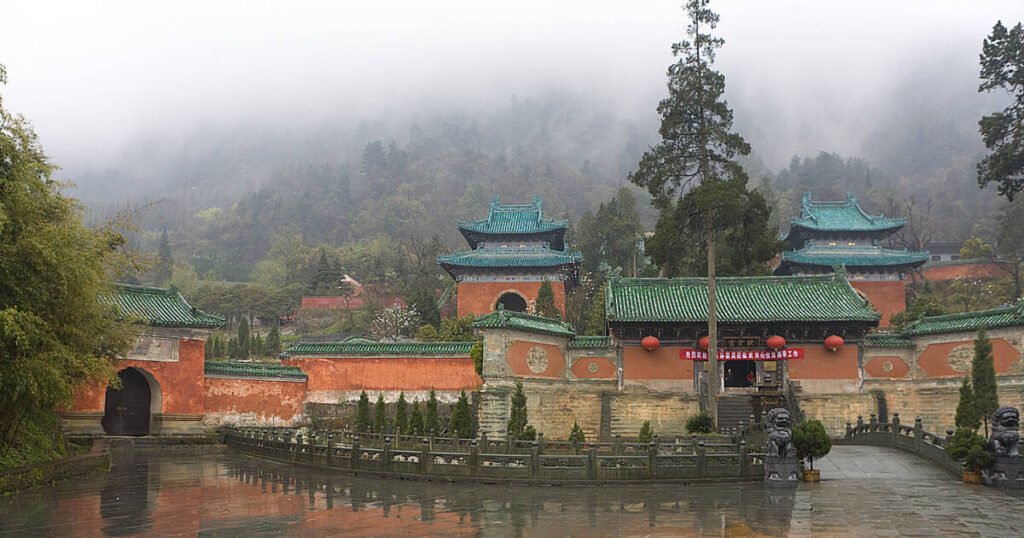
An Essential Guide to Visiting Wudang Mountains Ancient Building Complex
In This Guide
- An Essential Guide to Visiting Wudang Mountains Ancient Building Complex
- The Rich History and Legends of Wudang Mountains Ancient Building Complex
- Main Highlights: What You Absolutely Can’t Miss
- Planning Your Visit: A Practical Guide
- Tickets: Prices, Booking, and Tips
- How to Get There: A Complete Transportation Guide
- Local Cuisine and Accommodation Nearby
- Frequently Asked Questions
- Final Thoughts on Your Trip
Nestled among the dramatic peaks and serene valleys of Hubei Province, the Wudang Mountains Ancient Building Complex beckons travelers with a rich tapestry of history, architecture, and spirituality. Recognized as a UNESCO World Heritage Site, this remarkable collection of temples, palaces, and monasteries stands as a testament to the pinnacle of Chinese architectural artistry, spanning nearly a millennium from the 7th to the 17th century.
The Wudang Mountains are not just a feast for the eyes; they are a pilgrimage destination for those seeking a deeper understanding of Taoism, one of China’s indigenous spiritual traditions. The site flourished under the patronage of emperors, particularly during the Ming Dynasty, who sought to align their reigns with the philosophical and cultural tenets of Taoism. This rich history is palpable as you wander through the intricately designed structures, each telling a story of devotion, artistry, and imperial grandeur.
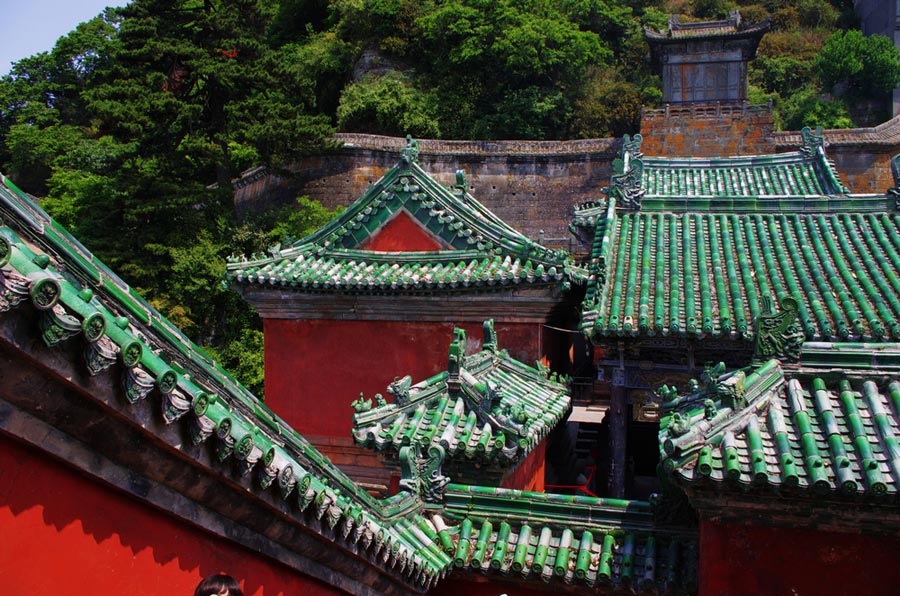
Wudang Mountains Ancient Building Complex.
What Makes Wudang Special?
-
Architectural Marvels: The complex showcases a fusion of natural beauty and human creativity, with ancient buildings harmoniously integrated into the mountainous landscape. Structures like the Golden Shrine and the Purple Heaven Palace exemplify the heights of Chinese architectural design.
-
Cultural Significance: As a center of Taoism, the Wudang Mountains are steeped in religious and cultural significance. The complex houses numerous temples and shrines that serve as sites of worship and meditation, providing insight into the philosophical underpinnings of one of Asia’s major religions.
-
Breathtaking Scenery: Beyond the architectural splendor, the natural beauty surrounding the complex is awe-inspiring. Towering peaks, lush forests, and winding pathways create a tranquil environment conducive to reflection and exploration.
-
Preservation and Protection: The Ancient Building Complex is under strict conservation measures, ensuring that its historical integrity is maintained for future generations to appreciate and learn from.
For international travelers eager to immerse themselves in Chinese history and culture, a visit to the Wudang Mountains Ancient Building Complex offers an unparalleled opportunity. Prepare to embark on a journey that transcends time, where the echoes of ancient rituals and the whispers of nature combine to create an experience unlike any other. Whether you are an architecture enthusiast, a spiritual seeker, or a history buff, Wudang promises to enrich your understanding of China’s profound cultural heritage.

Wudang Mountains Ancient Building Complex.
The Rich History and Legends of Wudang Mountains Ancient Building Complex
The Wudang Mountains, a UNESCO World Heritage site located in Hubei Province, China, are not only celebrated for their breathtaking natural beauty but also for their rich tapestry of history and legends. This ancient building complex, nestled among the peaks and valleys, stands as a testament to the cultural and spiritual evolution of Chinese civilization over nearly a millennium.
A Historical Overview
The history of the Wudang Mountains can be traced back to the early Tang Dynasty (618-907 AD), when they were established as a center for Taoism, one of China’s major religions. The complex reached its zenith during the Ming Dynasty (1368-1644), particularly under the reign of Emperor Zhu Di, who sought to align his imperial authority with Taoist teachings. His efforts led to an expansive building campaign that resulted in the construction of nine palaces, nine monasteries, 36 nunneries, and 72 temples, all harmoniously integrated into the natural landscape.
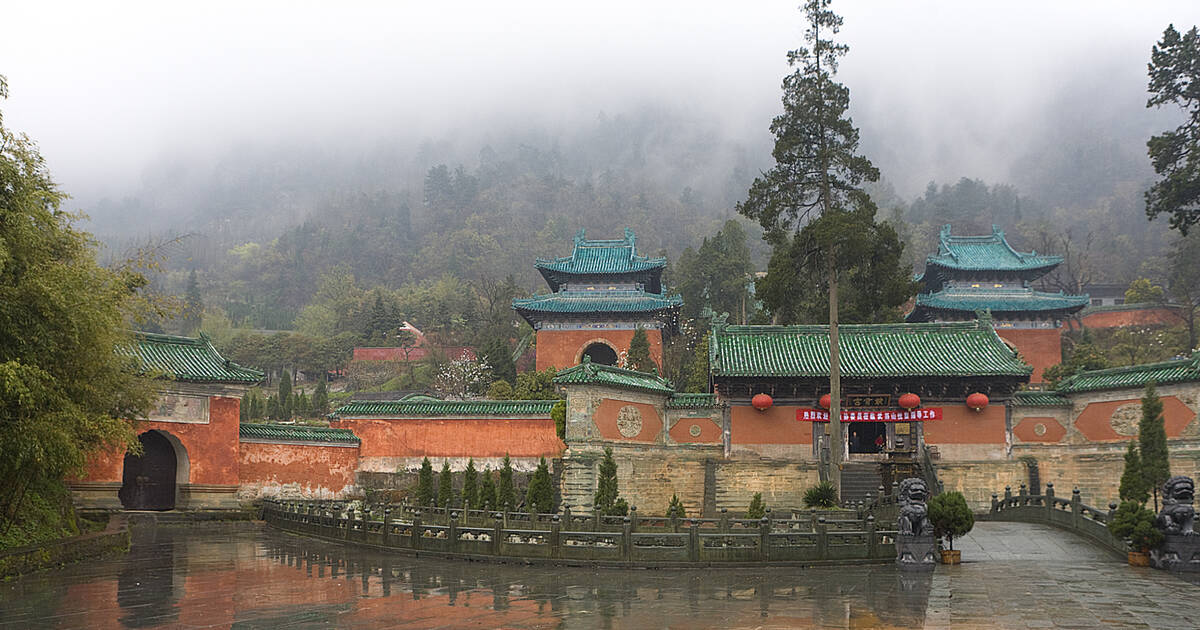
Wudang Mountains Ancient Building Complex.
The architectural styles of the complex reflect the artistry of the Yuan, Ming, and Qing dynasties, showcasing the evolution of Chinese architecture and the sophistication of its aesthetics. Among the most notable structures are the Golden Shrine, the Purple Heaven Palace, and the Ancient Bronze Shrine, each representing a unique facet of Taoist philosophy and imperial patronage.
Legends of the Wudang Mountains
The Wudang Mountains are steeped in legends that intertwine with the historical narrative, adding a mystical layer to their significance. According to folklore, the mountains are said to be the dwelling place of Zhang Sanfeng, a legendary figure credited with founding Tai Chi. Zhang is often depicted as a wise and immortal Taoist monk who achieved enlightenment through meditation and martial arts practice in the serene environment of Wudang.

Wudang Mountains Ancient Building Complex.
One popular legend recounts how Zhang Sanfeng, while observing a fight between a snake and a crane, was inspired to develop Tai Chi by synthesizing the movements of both animals. This story not only highlights the connection between nature and martial arts but also underscores the spiritual philosophy that permeates Wudang’s teachings.
Another captivating tale involves the Taoist Eight Immortals, who are said to have frequented the Wudang Mountains, bestowing blessings and wisdom upon the practitioners and seekers of truth who ventured there. Each of the Eight Immortals embodies different virtues and powers, and their influence is often felt in the teachings and practices that have emerged from this sacred site.
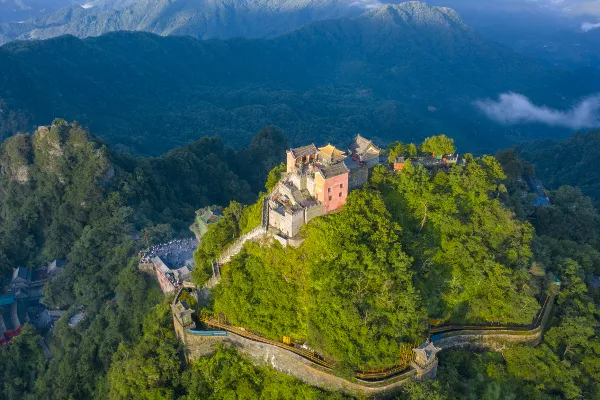
Wudang Mountains Ancient Building Complex.
Cultural Significance
The Wudang Mountains are not merely a collection of ancient buildings; they embody the essence of Taoist philosophy and the spiritual journey of countless practitioners over the centuries. The complex serves as a living museum, where the architectural achievements of the past meet the ongoing practices of Taoism today. This harmonious blend of history, legend, and spirituality makes Wudang a significant pilgrimage destination for both locals and international travelers seeking a deeper understanding of Chinese culture.
Conclusion
Visiting the Wudang Mountains Ancient Building Complex offers a unique opportunity to immerse oneself in a world where history and legend converge. As you wander through the majestic temples and palaces, you are not only stepping into an architectural marvel but also into the stories and philosophies that have shaped Chinese civilization for over a thousand years. Whether you are drawn by the allure of martial arts, the quest for spiritual enlightenment, or the appreciation of cultural heritage, the Wudang Mountains promise an unforgettable journey through time and legend.
Main Highlights: What You Absolutely Can’t Miss
When exploring the Ancient Building Complex in the Wudang Mountains, you are stepping into a realm where centuries of spirituality, architectural brilliance, and natural beauty converge. This UNESCO World Heritage site is not just a feast for the eyes; it is a treasure trove of history and culture waiting to be uncovered. Here are the main highlights you absolutely cannot miss during your visit:
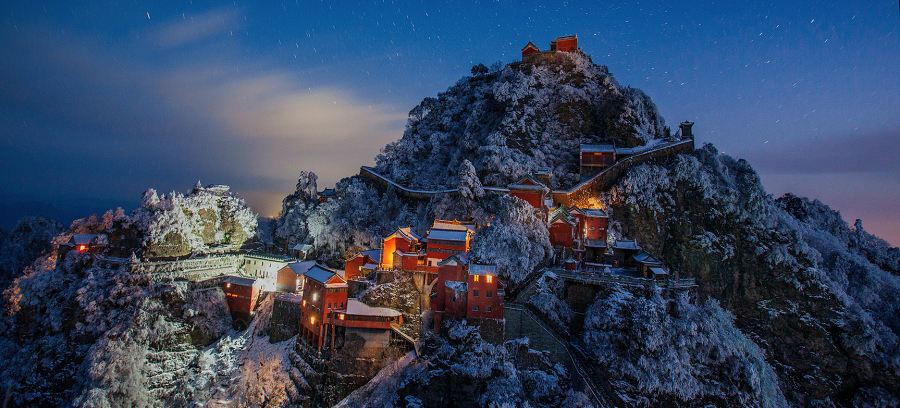
Wudang Mountains Ancient Building Complex.
1. The Golden Shrine (金殿)
Arguably the most iconic structure in Wudang, the Golden Shrine is a stunning example of ancient Chinese architecture. Constructed in 1307, this bronze building is renowned for its intricate artistry and is believed to house the spirit of the Taoist deity Zhenwu. The shrine’s majestic presence against the backdrop of the mountain peaks is a sight you won’t forget.
2. The Purple Heaven Palace (紫霄宫)
Dating back to the 12th century, the Purple Heaven Palace epitomizes the grandeur of Taoist architecture. Rebuilt and expanded in the 15th and 19th centuries, this palace features elaborate carvings and vibrant colors that reflect the spiritual richness of Taoism. Its serene atmosphere makes it a perfect spot for reflection and appreciation of the surrounding landscape.
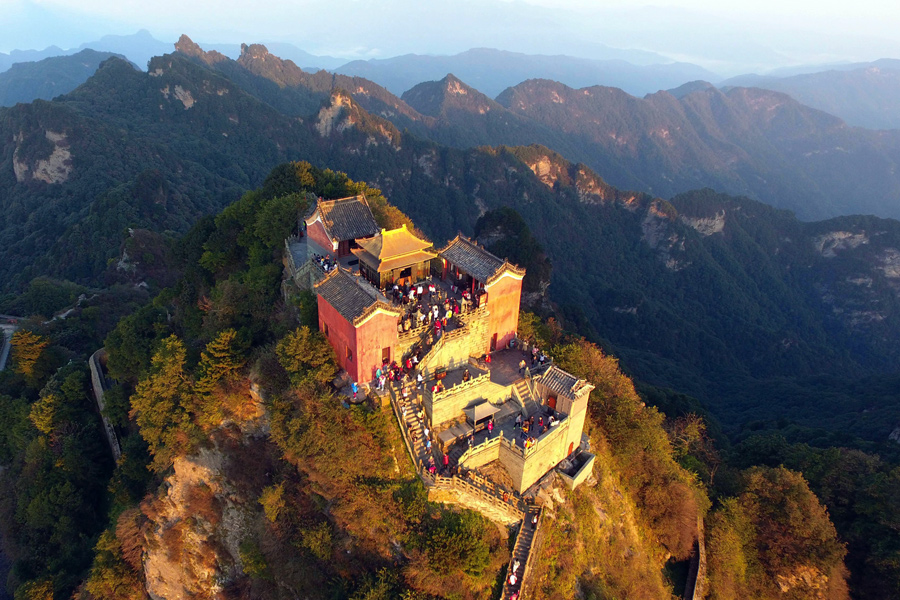
Wudang Mountains Ancient Building Complex.
3. The Nanyang Palace (南阳宫)
This palace, which dates back to the 12th and 13th centuries, is a splendid representation of the Ming Dynasty’s architectural style. Nestled in the embrace of the mountains, Nanyang Palace offers a glimpse into the opulence of imperial life while providing breathtaking views of the surrounding valleys.
4. The Fuzhen Temple (复真观)
Constructed during the 15th and 17th centuries, Fuzhen Temple stands as a testament to the deep-rooted Taoist traditions of the Wudang Mountains. The temple is not only a place of worship but also a center for Taoist learning and practice, making it a significant cultural site.
5. The Zhishi-Xuanyue Gateway (致士玄月门)
Built in 1522, this stone gateway marks the entrance to the Wudang Mountains and is a significant historical monument. The gateway symbolizes the connection between the earthly realm and the mystical world of Taoism. Its robust structure and intricate designs make it an excellent photo opportunity.
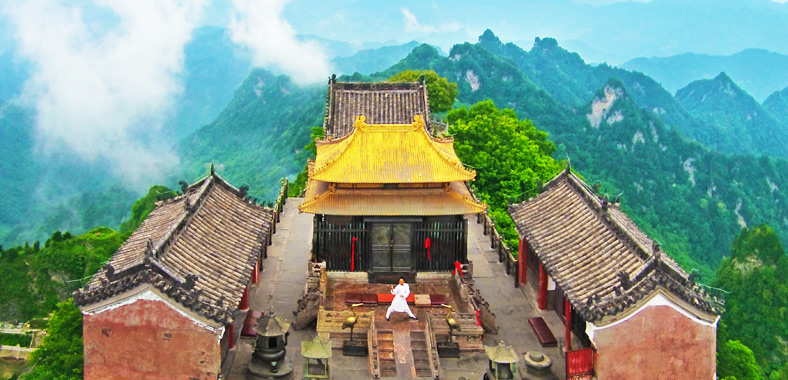
Wudang Mountains Ancient Building Complex.
6. Scenic Trails and Natural Beauty
The Wudang Mountains are renowned for their stunning natural landscapes. As you explore the complex, be sure to take advantage of the numerous hiking trails that wind through lush forests and offer panoramic views of the valleys below. The interplay of ancient architecture and natural beauty creates an enchanting atmosphere that is both peaceful and invigorating.
7. The Historical Significance
Beyond the stunning structures, the Wudang Mountains serve as a vital center for the development of Taoism in China. The complex’s rich history, which spans nearly a millennium, showcases the evolution of religious practices and imperial patronage throughout the Yuan, Ming, and Qing dynasties. Engaging with the stories behind each building enhances the experience of visiting this cultural gem.
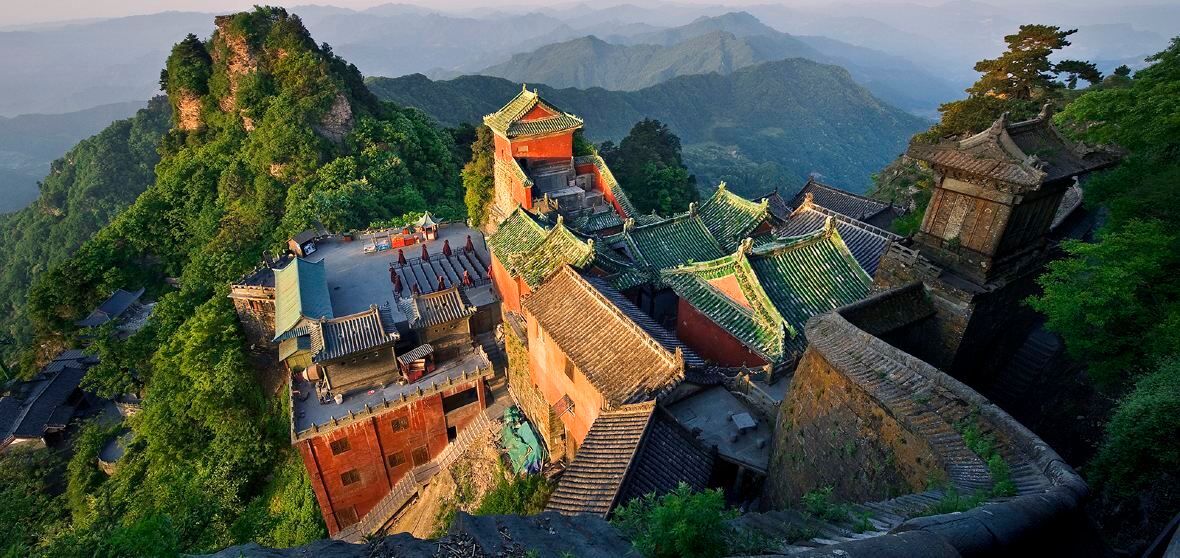
Wudang Mountains Ancient Building Complex.
8. Engaging with Local Culture
While visiting, take the time to engage with the local Taoist practitioners and guides. They can provide unique insights into the rituals, philosophies, and traditions that are still practiced in this sacred space. Participating in a Tai Chi class or observing a ritual can deepen your appreciation for the living culture of the Wudang Mountains.
Conclusion
The Ancient Building Complex in the Wudang Mountains is not just a destination; it is an experience that immerses you in the essence of Chinese history and spirituality. From its awe-inspiring architecture to its serene natural landscapes, every aspect beckons you to explore, reflect, and connect with the profound heritage of Taoism. Don’t miss the chance to witness this UNESCO World Heritage site; it promises to leave you with memories that will last a lifetime.
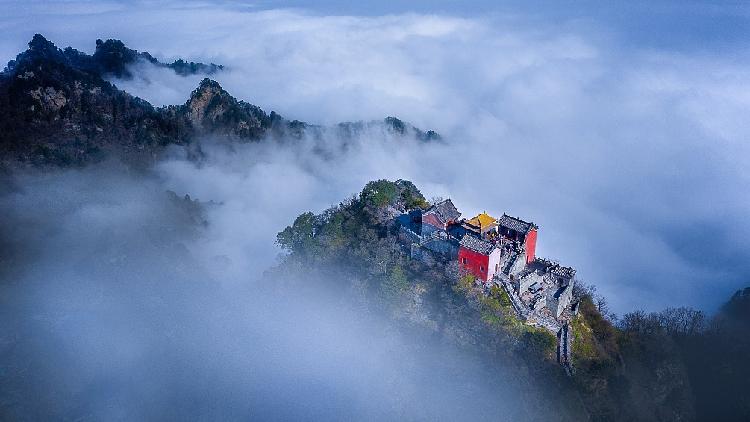
Wudang Mountains Ancient Building Complex.
Planning Your Visit: A Practical Guide
Preparing for Your Journey to the Wudang Mountains Ancient Building Complex
Visiting the Wudang Mountains Ancient Building Complex is an enriching experience that immerses travelers in China’s deep history and spiritual heritage. Nestled in the picturesque Hubei Province, this UNESCO World Heritage site is famed for its stunning architecture and significance in Taoist culture. To ensure your visit is enjoyable and insightful, here’s a practical guide to help you plan your adventure.
Getting There
Location:
The Wudang Mountains are located in the northern part of Hubei Province, approximately 12 kilometers from the city of Wudangshan.
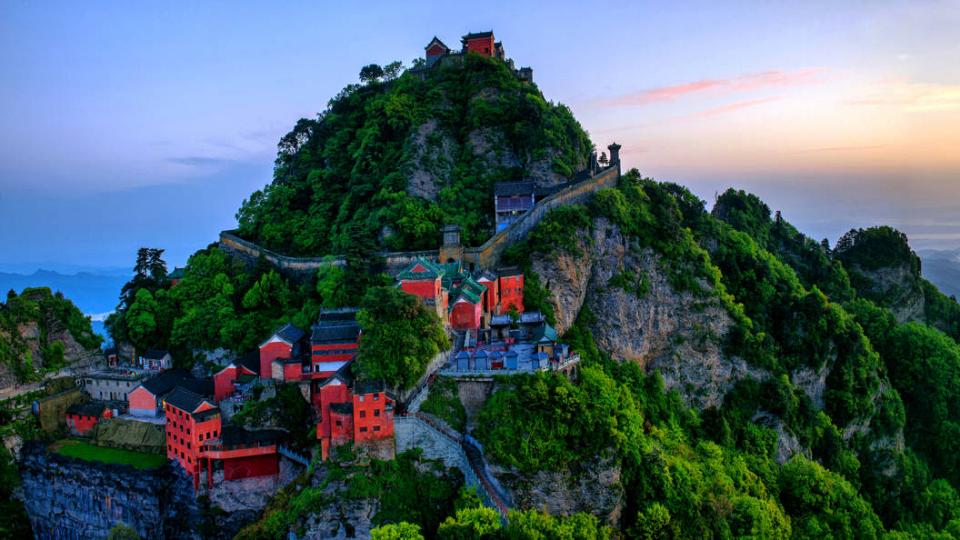
Wudang Mountains Ancient Building Complex.
Transportation Options:
– By Air: The nearest airport is the Wudangshan Airport, which offers domestic flights from major cities like Beijing and Shanghai. From the airport, you can take a taxi or arrange for hotel pick-up.
– By Train: Wudangshan Railway Station has regular services from cities such as Wuhan and Xiangyang. Once you arrive, local taxis or buses can take you to the mountain entrance.
– By Bus: Long-distance buses run to Wudangshan from nearby cities, making this a budget-friendly option.
Best Time to Visit
Ideal Seasons:
– Spring (March to May): The mountains come alive with blooming flowers, making it a beautiful time to explore.
– Autumn (September to November): This season offers stunning foliage and clear skies, providing perfect hiking conditions.

Wudang Mountains Ancient Building Complex.
Avoiding Crowds:
Weekdays are typically less crowded compared to weekends and public holidays, which is when many locals visit.
Entrance Fees and Opening Hours
- Entrance Fee: Approximately ¥100 (Chinese Yuan) for adults. Discounts may be available for students and seniors.
- Opening Hours: Generally open from 7:00 AM to 6:00 PM. However, hours may vary seasonally, so check in advance.
What to See and Do
Key Attractions:
– Golden Shrine (金殿): A stunning example of Ming dynasty architecture, this shrine offers breathtaking views and a glimpse into the spiritual life of Taoism.
– Purple Heaven Palace (紫霄宫): This majestic palace is known for its intricate carvings and serene atmosphere, perfect for reflection.
– Ancient Bronze Shrine (古铜殿): Dating back to 1307, this structure is one of the oldest in the complex and showcases the craftsmanship of its time.
Activities:
– Hiking: With trails ranging from easy walks to challenging climbs, the mountainous terrain is perfect for all levels of hikers. Be sure to wear sturdy shoes and carry water.
– Taoist Practices: Participate in Tai Chi classes or observe traditional Taoist ceremonies, enriching your cultural experience.
Tips for a Smooth Visit
- Dress Appropriately: Given the mountainous terrain, wear comfortable clothing and shoes suitable for hiking. Layering is advisable as temperatures can vary.
- Stay Hydrated: Bring water bottles, especially during hikes. There are limited facilities once you are on the trails.
- Respect the Culture: As a sacred site, maintain a respectful demeanor, particularly in religious areas. Photography may be restricted in certain locations.
Accommodations
Where to Stay:
– Hotels in Wudangshan Town: Options range from budget hostels to mid-range hotels. Booking in advance is recommended, especially during peak travel seasons.
– Guesthouses: For a more intimate experience, consider staying in local guesthouses that often offer meals and guided tours of the area.
Local Cuisine
Don’t miss out on trying the local dishes:
– Wudang Mountain Tofu: Known for its unique flavor, often served in hot pots or stir-fried dishes.
– Wild Herbs: Many local restaurants serve dishes featuring fresh mountain herbs, celebrated for their health benefits.
Conclusion
A visit to the Wudang Mountains Ancient Building Complex is not just about exploring architectural wonders; it’s an opportunity to connect with centuries of history and spirituality. With careful planning and an open mind, you’ll find yourself captivated by the beauty and significance of this remarkable site. Enjoy your journey!
Tickets: Prices, Booking, and Tips
When planning your visit to the breathtaking Wudang Mountains Ancient Building Complex, it’s essential to understand the ticketing details, prices, and some handy tips to make the most of your experience. This UNESCO World Heritage site offers a unique glimpse into Chinese history, architecture, and Taoist culture, and getting the right tickets will ensure a smooth journey.
Ticket Prices
- General Admission: Approximately ¥70 (CNY) per person. This ticket grants you access to the main areas of the complex, including several temples and palaces.
- Student Discounts: Full-time students with valid identification can enjoy a reduced price of around ¥35 (CNY).
- Senior Citizens: Visitors aged 60 and above can enter for about ¥35 (CNY) as well, so bring your ID to avail this discount.
- Children: Kids under the age of 1.2 meters can enter for free, while those between 1.2 meters and 1.5 meters may require a ticket at a discounted rate.
Booking Tickets
- Online Booking: Tickets can be purchased in advance through various online platforms or the official Wudang Mountains tourism websites. This is highly recommended during peak travel seasons to avoid long queues.
- On-Site Purchase: If you prefer spontaneity, tickets are also available at the entrance. However, be prepared for possible wait times, especially on weekends and holidays.
Tips for Your Visit
-
Timing Your Visit: The best time to explore the Wudang Mountains is during the spring (April – June) and autumn (September – November) when the weather is mild and the scenery is particularly stunning. Early mornings are ideal to experience the tranquility of the area before the crowds arrive.
-
Guided Tours: Consider joining a guided tour for a more enriching experience. Knowledgeable guides can provide insights into the historical significance of the various structures and the Taoist culture associated with the site.
-
What to Wear: Comfortable shoes are a must, as exploring the complex involves quite a bit of walking, often uphill. Dress in layers, as temperatures can vary significantly throughout the day.
-
Respect Cultural Norms: As you wander through this sacred site, maintain a respectful demeanor, especially in prayer areas and temples.
-
Photography: While photography is generally permitted, be mindful of any restrictions in certain areas, especially where religious ceremonies may be taking place.
-
Stay Hydrated and Snack Smart: There are limited food and drink options within the complex, so carry a water bottle and some snacks to keep you energized for your exploration.
Visiting the Wudang Mountains Ancient Building Complex is not just a trip; it’s a journey through time, culture, and spirituality. By planning ahead and following these tips, you’ll be well-prepared to immerse yourself in the rich history and stunning architecture that this remarkable site has to offer. Enjoy your travels!
How to Get There: A Complete Transportation Guide
Navigating Your Journey to the Wudang Mountains Ancient Building Complex
Revered for its rich tapestry of history and culture, the Wudang Mountains Ancient Building Complex in Hubei Province is a must-visit for international travelers keen to explore China’s architectural and spiritual heritage. This guide will help you navigate the various transportation options available to reach this UNESCO World Heritage site.
Getting to Wudang Mountains
1. By Air:
The nearest major airport to the Wudang Mountains is Wuhan Tianhe International Airport (WUH), located approximately 300 kilometers (about 186 miles) away. This airport is well-connected to major cities worldwide.
- Flights: Look for direct flights from major international airports to Wuhan. Airlines such as China Southern, Air China, and Hainan Airlines operate numerous routes.
- Transfer to Wudang Mountains: Once you arrive at Wuhan, you can choose from the following options to reach Wudang:
2. By Train:
The most efficient way to travel from Wuhan to the Wudang Mountains is via train.
- Wuhan to Wudangshan Railway Station:
- Duration: Approximately 2-3 hours.
- Train Types: High-speed trains (G-series) and regular trains (K-series).
- Tickets: Tickets can be purchased online through the China Railway website or at the train station.
3. By Bus:
For those preferring a more scenic route, taking a bus from Wuhan is another option.
- Buses to Wudangshan:
- Departure Points: Buses leave from the Wuhan Long-distance Bus Station.
- Duration: Approximately 4-5 hours.
- Frequency: Buses run regularly throughout the day, but it’s advisable to check the schedule in advance.
Local Transportation
Once you arrive in the town of Wudangshan, getting to the Ancient Building Complex is straightforward:
1. Taxi Services:
– Taxis are readily available at the bus and railway stations. Ensure the driver uses the meter or agree on a fare beforehand.
2. Shuttle Buses:
– There are shuttle buses that operate between Wudangshan’s central areas and the Ancient Building Complex. These are often timed with train and bus arrivals.
3. Walking:
– For the adventurous traveler, the complex is accessible via scenic walking trails from Wudangshan town. This option allows you to immerse yourself in the beautiful surroundings.
Tips for Travelers
- Plan Ahead: Given the site’s popularity, especially during weekends and holidays, it’s wise to book transportation and accommodation in advance.
- Language: While many signs are bilingual, it’s helpful to have a translation app or a phrasebook, as English may not be widely spoken.
- Weather Considerations: The best times to visit are spring (April to June) and autumn (September to November) when the weather is mild and the scenery is at its most beautiful. Be prepared for cooler temperatures at higher altitudes.
Conclusion
Traveling to the Wudang Mountains Ancient Building Complex offers an enriching experience that combines breathtaking landscapes with profound cultural history. Whether you choose to fly, take a train, or hop on a bus, the journey to this spiritual heartland will be as memorable as the destination itself. Embrace the adventure, explore the ancient pathways, and immerse yourself in the ethereal beauty of Taoist architecture that has stood the test of time.
Local Cuisine and Accommodation Nearby
Discovering Local Delights and Comfortable Stays Near the Wudang Mountains
When visiting the Ancient Building Complex in the Wudang Mountains, travelers not only immerse themselves in centuries of Taoist history and exquisite architecture but also have the opportunity to indulge in the local cuisine and find comfortable accommodations nearby. Here’s a guide to help you savor the flavors and rest well after exploring this UNESCO World Heritage site.
Local Cuisine
The region surrounding Wudang Mountains is renowned for its rich culinary heritage that reflects the flavors of Hubei Province. Here are some dishes and local specialties to try:
-
Wudang Tofu (武当豆腐): This dish features tofu made from locally sourced soybeans, often stir-fried with seasonal vegetables and spices, offering a delightful balance of texture and taste.
-
Spicy Duck Neck (鸭脖): A popular snack in Hubei, the duck neck is marinated in a blend of spicy, aromatic herbs and served cold or warm, making it a perfect accompaniment to a local beer.
-
Steamed Fish (清蒸鱼): Freshwater fish from the nearby rivers are delicately steamed with ginger and scallions, highlighting the natural flavors, often served with a side of rice or noodles.
-
Hot and Sour Noodles (酸辣面): This beloved dish features wheat noodles tossed in a spicy and tangy sauce, often garnished with peanuts and cilantro, providing a comforting yet invigorating meal.
-
Wudang Mountain Chicken (武当山鸡): This specialty chicken dish is slow-cooked with a variety of herbs and spices, resulting in tender meat and a rich, aromatic broth.
For a truly authentic experience, consider dining at Local Eateries such as:
-
Jin Zhi Wei Restaurant: Known for its traditional Hubei dishes and warm atmosphere, this restaurant is a favorite among locals and tourists alike.
-
Wudang Mountain Vegetarian Restaurant: Located near the temples, this eatery specializes in vegetarian dishes, ideal for those following a Taoist diet.
Accommodation Options
After a day of exploring the majestic peaks and ancient temples, you’ll want a cozy place to unwind. Here are some recommended accommodations near the Wudang Mountains:
-
Wudangshan International Hotel: With stunning views of the mountains, this hotel offers modern amenities, comfortable rooms, and an on-site restaurant serving local cuisine. It’s an excellent choice for both relaxation and convenience.
-
Wudang Mountain Scenic Area Guesthouse: Perfect for budget travelers, this guesthouse provides basic yet comfortable accommodations. It’s located close to the main attractions, making it easy to explore the area.
-
Taoist Culture Hotel: This unique hotel immerses guests in Taoist culture, featuring traditional decor and practices. It’s a peaceful retreat, complete with meditation spaces and guided experiences.
-
Mount Wudang Zen Inn: A tranquil option just a short distance from the main complex, this inn focuses on harmony and relaxation, offering a serene environment for reflection after a day of exploration.
-
Wudangshan Baoding Hotel: Situated near the foot of the mountain, this hotel combines comfort with accessibility, making it easy to embark on hiking trails or visit the ancient buildings.
Whether you’re savoring the local flavors or resting in a cozy inn, your visit to the Wudang Mountains will be enhanced by these culinary and accommodation delights. Embrace the rich culture and history as you enjoy the unique offerings of this enchanting region.
Frequently Asked Questions
Frequently Asked Questions about the Wudang Mountains Ancient Building Complex
1. What is the Wudang Mountains Ancient Building Complex?
The Wudang Mountains Ancient Building Complex is a UNESCO World Heritage site located in Hubei Province, China. It consists of an impressive collection of palaces, temples, and other structures that exemplify the architectural and artistic achievements of the Yuan, Ming, and Qing dynasties. The complex is renowned as a center for Taoism and showcases nearly 1,000 years of Chinese history and culture.
2. When were the buildings in the complex constructed?
The majority of the buildings we see today were constructed during the Ming Dynasty (14th-17th centuries), although some Taoist structures date back to as early as the 7th century. The complex reached its zenith during this period, thanks to significant construction efforts initiated by Emperor Zhu Di to align his rule with Taoist principles.
3. How many buildings are part of the complex?
Currently, 53 ancient buildings and 9 architectural sites remain within the Wudang Mountains Ancient Building Complex. Notable structures include the Golden Shrine, the Purple Heaven Palace, and various temples and monasteries, many of which are remarkable examples of ancient Chinese architecture.
4. What is the significance of the Wudang Mountains in Taoism?
The Wudang Mountains are considered one of the most important Taoist sacred sites in China. They have been a center for Taoist practice since the early Tang Dynasty, attracting monks, scholars, and emperors alike. The complex not only reflects the religious significance of Taoism but also its influence on Chinese philosophy and culture.
5. How can I get to the Wudang Mountains?
The Wudang Mountains are accessible by train and bus from major cities like Wuhan and Xiangyang. The nearest train station is in Wudangshan Town, which is a short bus ride from the entrance to the site. Once there, visitors can explore the area on foot or hire local guides for a more in-depth experience.
6. What should I wear and bring for a visit?
Comfortable walking shoes are essential, as the complex involves considerable walking and climbing. Dress in layers, as the weather can change quickly in the mountains. It’s advisable to bring water, snacks, a camera for capturing the stunning scenery, and perhaps a guidebook or map for reference.
7. Are there accommodations available near the Wudang Mountains?
Yes, there are several options for accommodations ranging from budget hostels to upscale hotels in Wudangshan Town. Many establishments offer convenient access to the mountain trails and are equipped to cater to tourists exploring the historical sites.
8. Is there an entry fee for the Wudang Mountains Ancient Building Complex?
Yes, there is an entry fee to access the complex, which helps fund its preservation and maintenance. It is advisable to check in advance for updated pricing and any additional costs for guided tours or special activities.
Final Thoughts on Your Trip
As you prepare to leave the enchanting Wudang Mountains Ancient Building Complex, take a moment to reflect on the journey you’ve undertaken through time and culture. Here, amidst the majestic peaks and serene valleys, you have walked in the footsteps of emperors, monks, and scholars who have shaped the rich tapestry of Chinese history.
A Journey Beyond the Physical
Visiting the Wudang Mountains is not merely about exploring architectural marvels; it is an immersion into Taoist philosophy, ancient artistic expression, and the harmonious relationship between nature and spirituality. Each temple, each stone pathway, tells a story that transcends centuries, inviting you to ponder the significance of balance and tranquility in your own life.
Cherishing the Legacy
The UNESCO World Heritage site stands not only as a testament to the architectural achievements of the Yuan, Ming, and Qing dynasties but also as a vibrant center of Taoism. As you depart, consider the profound influence this sacred space has had on the development of religious thought and public art across China. The intricate designs and serene landscapes serve as a reminder of the cultural heritage that continues to thrive, protected and cherished for future generations.
Take Home the Experience
Before you leave, take a moment to breathe in the fresh mountain air and soak in the stunning vistas. Allow the peaceful atmosphere to settle within you, carrying a piece of Wudang’s wisdom back to your everyday life. Whether it’s in the form of a cherished memory, a newfound understanding of Taoism, or simply a sense of peace, let your experience here enrich your journey ahead.
As you conclude your visit to the Wudang Mountains, remember that the spirit of this place lingers long after you leave. It invites you to reflect on your own path, to seek harmony within yourself, and to embrace the beauty that surrounds you. Safe travels!